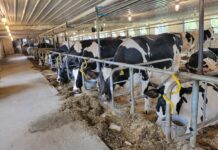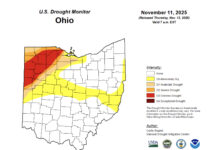By Jason Hartschuh
The earliest planted corn across the state began to tassel last week, and tasseling will continue for about the next month based on when your corn was planted. Scouting each cornfield as it begins to tassel and assessing weather conditions is an important part of making fungicide decisions on your farm.
When fungal disease is present in corn silage at tassel, a fungicide application at VT-R1 to control these fungal diseases reduced fiber concentration and improved nutritional value compared to the untreated control. Corn treated with fungicide had improved fermentation and more consistent dry matter values.
When fungal disease infects corn one of its natural responses to stop the spread of the disease is to increase lignin around the infected area to stop the disease spread which reduces digestibility.
Tar spot
Tar spot was first reported in Ohio in 2021 with only very late season reports in 2022. Research has shown that later-planted corn is at the greatest risk of losses from tar spot. One of the greatest risks to corn silage is from severe infection causing premature plant death. Tar spot reduces silage moisture, digestibility and energy, which can also lead to poor fermentation with lower silage moisture and plant sugars.
Scouting for tar spot is critical and should be done weekly from tassel through R3. Lesions will be small, black, raised spots appearing on both sides of the leaves along with leaf sheaths and husks. If tar spot is found in fields a fungicide application can help slow disease spread but be cautious of the preharvest interval of the fungicide.
Other diseases
Other leaf diseases such as gray leaf spot, northern corn leaf blight, common rust and southern rust can also decrease digestibility and fermentation just not as rapidly as tar spot. Gray leaf spot has gray to tan lesions developing between the veins and are distinctly rectangular with smooth, linear margins along the leaf veins. Northern corn leaf blight lesions typically have a tan color and are elliptical or cigar-shaped with smooth rounded ends.
Common rust is rarely of economic concern but the development of southern rust can have economic yield impacts. The colors are different between the two, Common rust is brownish to a cinnamon-brown while southern rust has a reddish-orange appearance. Southern rust mostly develops on the top of the leaf and maybe on the stems and husks while Common rust is on both sides of the leaves and generally only on the leaves. Identifying the diseases present in your corn field can help you choose the best fungicide when they are needed.
Toxins
Maybe the biggest concern for dairy producers is mycotoxin contamination of corn silage and high moisture corn with many nutritionists encouraging levels below 1 ppm in corn utilized in the lactating ration. Fungicides may have the ability to reduce mycotoxin levels and improve silage digestibility.
DON is one of the primary vomitoxins in Ohio corn. It is caused by the fungus Fusarium graminearum and causes both Gibberella stalk rot and Gibberella ear rot, making it of concern for both the grain and forage quality.
One study under low Gibberella disease pressure saw that in all cases but one an application of fungicide at R1 reduced DON levels by at least 50%. The trial was then expanded the second year, which was a high disease pressure year with DON levels as high as 17.9 ppm in one hybrid and 30.3 ppm in the other hybrid. Again, fungicide had little effect on these two BMR hybrids yield or forage quality, but a few products did consistently lower DON levels. A 2021 corn silage trial in Ohio showed a vomitoxin reduction from 3.1 ppm in the control to 0.5 ppm with Miravis Neo application.
The products that consistently lowered DON levels contained a triazole as one of their active ingredients with prothioconazole being the most common. Three products that researchers across the country are seeing lower DON levels with when disease is present are Proline, Delaro, and Miravis Neo. The ideal application window from multiple studies has been R1 which is from the point when silks emerge until they become dry about 10 days later.
This application is primarily for Gibberlla ear rot which infects the ears during pollination. This does create some logistical issues with applications requiring high-clearance sprayers. We have not compared high-clearance sprayers to aerial applications yet but our research has shown that coverage at silk level is critical. We have seen better coverage at silk level when using 20 gallons per acre of spray compared to 15 gallons per acre.
(Jason Hartschuh is the OSU Extension field specialist in dairy management and precision livestock. He can be reached at hartschuh.11@osu.edu.)













